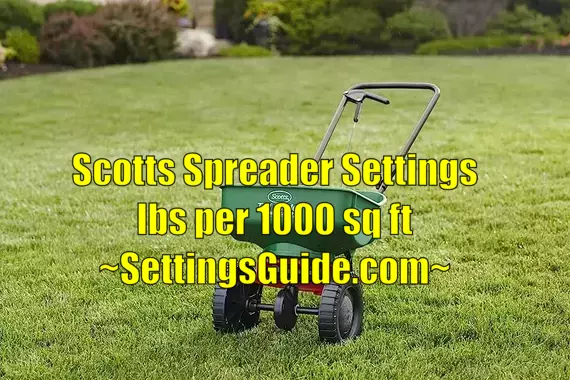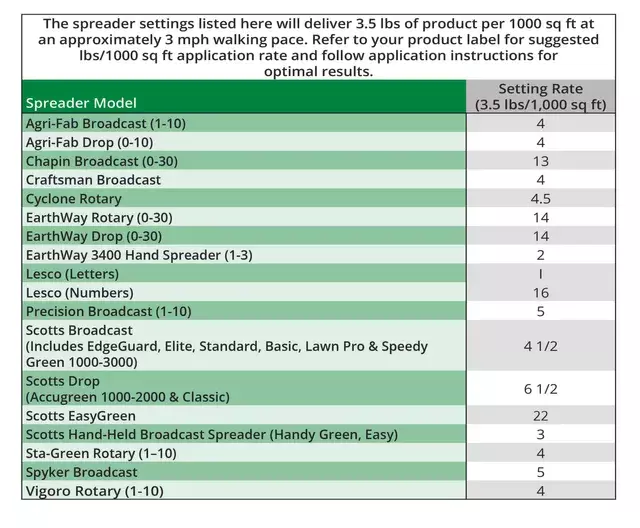When it comes to maintaining a lush and healthy lawn, Scotts spreaders are a popular choice among homeowners. These handy tools are designed to evenly distribute various agricultural chemicals. However, to get the best performance out of your Scotts spreader, it’s crucial to make the right adjustments.
In this article, we’ll dive into the recommended settings for different models of Scotts spreaders. Instead of relying on arbitrary values, we’ll focus on the Scotts Spreader Settings lbs per 1000 sq ft. This ensures that you can achieve optimal results when spreading fertilizer on your lawn. You can also apply the best Scotts Elite Spreader Settings with charts and guide.
Creating a beautiful and thriving lawn requires attention to detail, and the Scotts spreader is here to help. By understanding the correct settings in pounds per 1000 square feet, you can ensure that your lawn receives the perfect amount of fertilizer for healthy growth. Let’s uncover the secret of Scotts spreader settings and pave the way for a stunning lawn.
Types of Scotts Spreader
Scotts offers a range of spreaders designed to cater to different lawn care needs. Understanding the different types of Scotts spreaders can help you choose the right one for your specific requirements.
- Scotts Broadcast Spreaders: These spreaders are ideal for covering large areas quickly and evenly. They distribute fertilizer or other lawn care products in a wide, fan-like pattern, making them efficient for expansive lawns.
- Scotts Drop Spreaders: Drop spreaders provide more precision and accuracy. They release the fertilizer directly underneath the spreader, resulting in a controlled and targeted application. They are suitable for smaller lawns or areas that require precise product placement.
- Scotts Handheld Spreaders: Compact and easy to use, handheld spreaders are perfect for spot treatments or small patches of lawn. They are lightweight and allow for easy maneuverability, making them ideal for quick and convenient applications.
By understanding the different types of Scotts spreaders and their specific features, you can choose the one that best suits your lawn size, application needs, and personal preferences.

Finding the Right Scotts Spreader Settings
Finding the right Scotts spreader settings is crucial for achieving optimal results when fertilizing your lawn. Here are some steps to help you determine the correct settings:
- Read the Instructions: Start by carefully reading the product instructions provided by Scotts. They often include recommended spreader settings for their specific fertilizers.
- Calibrate Your Spreader: Calibration is essential to ensure accurate application. Follow the manufacturer’s instructions to calibrate your spreader and determine its output rate.
- Consider Lawn Size: Adjust the spreader settings based on the size of your lawn. Larger areas may require higher settings, while smaller areas need lower settings for proper coverage.
- Account for Fertilizer Type: Different fertilizers have varying densities such as Republic EZ Broadcast Spreader. Adjust the settings accordingly to accommodate the specific fertilizer you are using.
- Walk at a Steady Pace: Maintain a consistent walking speed when operating the spreader. This helps ensure even distribution of the fertilizer across your lawn.
- Check for Overlap: Be mindful of overlapping passes to avoid over-application. Adjust the settings to compensate for any overlap and prevent uneven distribution.
By following these steps and considering factors like lawn size, fertilizer type, and calibration, you can find the right Scotts spreader settings that will help you achieve a healthy and vibrant lawn.
Importance of Scotts Spreader Settings lbs per 1000 sq ft
The importance of Scotts Spreader Settings lbs per 1000 sq ft cannot be overstated when it comes to achieving a healthy and thriving lawn. These settings determine the precise amount of fertilizer that is applied to your lawn, ensuring optimal growth and nourishment.

By using the correct spreader settings, you can avoid under or over-fertilization, both of which can have detrimental effects on your lawn’s health. Under-fertilization may lead to nutrient deficiencies and a lackluster appearance, while over-fertilization can cause burning and damage to the grass.
The pounds per 1000 square feet measurement allows for accurate and consistent application across your lawn. It takes into account the size of the area and ensures that the right amount of fertilizer is evenly distributed. This helps prevent patchy areas or uneven growth. Do you know there is a complete setup guide on how to apply Scotts Spreader Setting for Lime for the maximum results.
Furthermore, using the recommended Scotts spreader settings promotes environmental responsibility by minimizing fertilizer waste and reducing the risk of nutrient runoff into water sources.
Scotts Spreader Settings lbs per 1000 sq ft
| Lawn Care Product | Spreader Setting (lbs per 1000 Sq. Ft) |
|---|---|
| Scotts Turf Builder | 4 |
| Scotts Weed and Feed | 4 |
| Scotts WinterGuard | 6 |
| Scotts Green Max | 5 |
| Scotts Starter Fertilizer | 3 |
| Scotts DiseaseEx | 3 |
| Scotts Moss Control | 4 |
Factors Affecting your Scotts spreader
The performance of your Scotts spreader can be influenced by several factors. Here are the key factors to consider when adjusting your spreader settings for optimal results:
- Type of Lawn Care Product: Different lawn care products have specific recommended application rates. It is essential to use the correct pounds per 1000 square feet (lbs per 1000 sq ft) setting for the particular product you are using. Following the product’s instructions will help ensure accurate application.
- Lawn Size: The size of your lawn or garden directly affects the amount of product you need to apply. Adjust the spreader setting accordingly to cover the entire area adequately. Larger areas may require higher settings, while smaller areas need lower settings.
- Type of Grass: Different grass types have varying fertilization needs such as Agri Fab Spreader. Consider the specific requirements of your grass when setting the spreader. Understanding the nutritional needs of your grass will help you achieve proper and balanced fertilization.
- Climate: Climate and weather conditions play a significant role in lawn health. Factors such as temperature, humidity, and rainfall impact the growth and nutrient absorption of plants. Adjust the spreader settings accordingly to accommodate your specific climate conditions.
- Soil Type: The type of soil and its pH levels can affect the availability of nutrients to plants. Understanding your soil type and pH levels will guide you in determining the appropriate spreader settings for effective fertilization.
- Season: Different seasons have different fertilization requirements. Adjust the spreader settings based on the time of year to address the specific needs of your lawn during each season.
Considering these factors when adjusting your Scotts spreader settings will help you achieve accurate and efficient application, resulting in a healthy and vibrant lawn or garden.
Final Words
In conclusion, using the correct Scotts Spreader Settings lbs per 1000 sq ft is vital for maintaining a healthy and lush lawn. By considering factors like the type of product, lawn size, grass type, climate, soil type, and season, you can ensure accurate and effective fertilizer application. With the right settings, your lawn will thrive, creating a beautiful outdoor space for you to enjoy.
